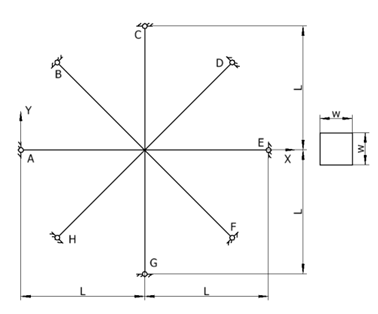Modal frequencies 01: in-plane vibration modes of a pin-ended double cross
A simply supported cross frame consists of eight beams that have a square section (0.125 x 0.125 meter).
Case Description
A simply supported cross frame consists of eight beams that have a square section (0.125 x 0.125 meter). The frame is 10 m x 10 m. Consider modes in the XY plane only (constrain the back face against translation in the Z direction). To simulate a pinned constraint at the end of a beam element, the solid model includes a cylindrical groove at the end of each spoke (at the centerline of the cross section). A radial pin constraint is applied to the face of each groove.
Calculate 20 modes. The benchmark comparison is performed on the first 16 modes only. Calculating 20 modes improves the accuracy of the highest few modes for comparison.

Study Type
- Modal Frequencies
Mesh Parameters
- Mesh Type = Solid, Tetrahedral
- Element Order = Parabolic
- Mesh Size = 31.25 mm, absolute (producing four elements through the thickness)
- Adaptive Mesh Refinement: None
Material Properties
- Modulus of elasticity = 2.0 X 105 MPa
- Density = 8000 kg/m3
- Poisson's ratio (v) = 0.3
Constraints
- Z-direction constrained at the back (-Z) face
- Pin constraint with only radial translation prevented. Apply to the half-cylinder groove at the center of each end of the square beam
Comparison of Results
The first 16 frequencies correspond to the benchmark as follows:
| Natural frequencies | F1 | F2 | F3 | F4 | F5 | F6 | F7 | F8 |
| NAFEMS (Beam Elements) |
11.336 Hz | 17.709 Hz | 17.709 Hz | 17.709 Hz | 17.709 Hz | 17.709 Hz | 17.709 Hz | 17.709 Hz |
| Fusion (Solid Elements) |
11.33 Hz | 18.38 Hz | 18.41Hz | 18.41 Hz | 18.48 Hz | 18.48 Hz | 18.51 Hz | 18.51 Hz |
| % Difference | 0.053 % | 3.79 % | 3.96 % | 3.96 % | 4.35 % | 4.35 % | 4.52 % | 4.52 % |
| Natural frequencies | F9 | F10 | F11 | F12 | F13 | F14 | F15 | F16 |
| NAFEMS (Beam Elements) |
45.345 Hz | 57.390 Hz | 57.390 Hz | 57.390 Hz | 57.390 Hz | 57.390 Hz | 57.390 Hz | 57.390 Hz |
| Fusion (Solid Elements) |
45.91 Hz | 59.39 Hz | 59.44 Hz | 59.44 Hz | 59.46Hz | 59.46 Hz | 59.66 Hz | 59.66 Hz |
| % Difference | 1.25 % | 3.48 % | 3.57 % | 3.57 % | 3.61 % | 3.61 % | 3.96 % | 3.96 % |
Reference
NAFEMS Publication Test No. FV2, The International Association for the Engineering Analysis Community, "NAFEMS Background To Benchmarks", G.A.O Davies, R.T. Fenner, R.W. Lewis, June, 1992.
